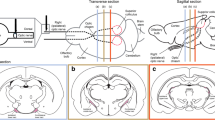Abstract
Blood-brain barrier (BBB) integrity is lost in several neurological conditions in which astrocytes are damaged. We studied 3-chloropropanediol-induced focal lesions, a toxicant that induces early astrocytic (but not neuronal) death followed by BBB leakage. T2-weighted images illustrate regional selectivity of the lesions, affected areas including the inferior colliculi and red nuclei. Gd-DTPA intensity quantified the degree of vascular leakage in the lesioned areas. MRI intensity in lesioned areas peaked at 2 days, correlating with BBB breakdown, and diminished thereafter, returning to pre-injection levels by 30 days in parallel with the return of astrocytes. T2 measurements were unchanged at 6 h, a time when astrocyte swelling is marked but the vasculature is intact, but increased at 2 days, consistent with cellular damage and BBB leakage. Gd-DTPA enhancement was also greatest at 2 days then decreased over the next 28 days, indicating a tracer-size-dependent rate of BBB repair. A simple model based on experimentally acquired data indicated that the vascular breakdown was the result of leakage of only a small percentage of blood vessels in the affected areas. Loss of astrocytes contributes to barrier loss, and restoration of astrocytes is needed for full barrier recovery.
Similar content being viewed by others
References
Willis CL, Nolan CN, Reith SN, Lister T, Prior MJW, Guerin CJ, Mavroudis G, Ray DE (2004) Focal astrocyte loss is followed by microvascular damage, with subsequent repair of the blood-brain barrier in the apparent absence of direct astrocytic contact. Glia 45:325–337
Rumpel H, Nedelcu J, Aguzzi A, Martin E (1997) Late glial swelling after acute cerebral hypoxia-ischaemia in the neonatal rat: a combined magnetic resonance and histochemical study. Pediatric Res 42:54–59
Romero IA, Rist RJ, Chan MWK, Abbot NJ (1997) Acute energy deprivation syndromes; investigation of m-dinitrobenzene and α-chlorohydrin toxicity on immortalised rat brain microvessel endothelial cells. Neurotoxicology 18:781–791
Fabene PF, Marzola P, Sbarbati A, Bentivoglio M (2003) Magnetic resonance imaging of changes elicited by status epilepticus in the rat brain: diffusion-weighted and T2-weighted images, regional blood volume maps, and direct correlation with tissue and cell damage. Neuroimage 18:375–389
Schuhmann MU, Stiller D, Skardelly M, Mokktarzadeh M, Thomas S, Brinker T, Samii M (2002) Determination of contusion and oedema volume by MRI corresponds to changes of brain water content following controlled cortical impact injury. Acta Neurochir Suppl 81:213–215
Nedelcu J, Klein MA, Aguzzi A, Boesiger P, Martin E (1999) Biphasic edema after hypoxic-ischemic brain injury in neonatal rats reflects early neuronal and late glial damage. Pediatr Res 46:297–304
Medana IM, Chan-Ling T, Hunt NH (1996) Redistribution and degeneration of retinal astrocytes in experimental murine cerebral malaria: relationship to disruption of the blood-retinal barrier. Glia 16:51–64
Willis CL, Leach L, Clarke GJ, Nolan CC, Ray DE Reversible disruption of tight junction complexes in the rat blood-brain barrier, following transitory focal astrocyte loss. Glia 48:1–13
Hennig J, Nauerth A, Friedburg H (1986) RARE imaging: a fast imaging method for clinical MR . Magn Reson Med. 3:823–833
Paxinos G, Watson C (1986) The rat brain in stereotaxic coordinates. Academic, Australia
Biewald N, Billmeier J (1978) Blood volume and extracellular space (ECS) of the whole body and some organs of the rat. Experientia 34:412–413
Derelanko MJ, Hollinger MA (1995) CRC handbook of toxicology. CRC, Boca Raton
Laule C, Vavasour IM, Moore GR, Oger J, Li DK, Paty DW, MacKay AL (2004) Water content and myelin water fraction in multiple sclerosis - a T2 relaxation study. J Neurol 251:284–293
Ewing JR, Knight RA, Nagaraja TN, Yee JS, Nagash V, Whitton PA, Li L, Fenstermacher JD (2003) Patlak plots of Gd-DTPA MRI data yield blood-brain transfer constants concordant with those of 14C-sucrose in areas of blood-brain opening. Magn Reson Med 50:283–292
Seo Y, Takamata A, Ogino T, Morita H, Nakamura S, Murakami M (2002) Water permeability of capillaries in the subfornical organ of rats determined by Gd-DTPA2- enhanced 1H magnetic resonance imaging. J Physiol 545:217–228
Brodie BB, Titus EO, Wilson CWN (1960) The absence of the blood-brain barrier from special areas of the brain. J Physiol 152:20–22
Cavanagh JB, Nolan CC, Seville MP (1993) The neurotoxicity of α-chlorohydrin in rats and mice: I . Evolution of the cellular changes. Neuropathol Appl Neurobiol 19:240–252
Schroeter M, Franke C, Stoll G, Hoehn M (2001) Dynamic changes of magnetic resonance imaging abnormalities in relation to inflammation and glial responses after photothrombotic cerebral infaction in the rat brain. Acta Neuropathol 101:114–122
Author information
Authors and Affiliations
Corresponding author
Rights and permissions
About this article
Cite this article
Prior, M., Brown, A., Mavroudis, G. et al. MRI characterisation of a novel rat model of focal astrocyte loss. MAGMA 17, 125–132 (2004). https://doi.org/10.1007/s10334-004-0065-5
Received:
Revised:
Accepted:
Published:
Issue Date:
DOI: https://doi.org/10.1007/s10334-004-0065-5




